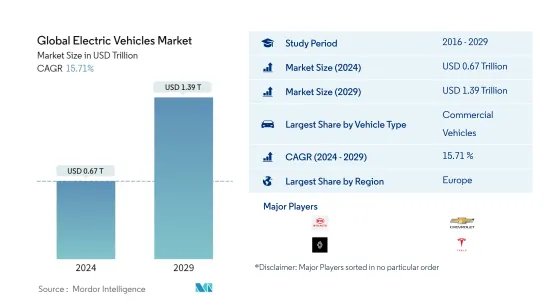 |
市場調查報告書
商品編碼
1431068
全球電動車:市場佔有率分析、產業趨勢/統計、成長趨勢預測(2024-2029)Global Electric Vehicles - Market Share Analysis, Industry Trends & Statistics, Growth Forecasts (2024 - 2029) |
||||||
價格
※ 本網頁內容可能與最新版本有所差異。詳細情況請與我們聯繫。
簡介目錄
預計2024年全球電動車市場規模將達到6,700億美元,預計2029年將達到1.39兆美元,預測期內(2024-2029年)複合年成長率為15.71%。

主要亮點
- 依燃料類型分類的最大區隔市場 - 純電動車:技術進步、充電基礎設施改善、嚴格的法規和獎勵使純電動車成為全球電動車市場上最大的燃料類型。
- 依燃料類型分類成長最快的區隔市場 - FCEV:FCEV 是成長最快的燃料類型,因為與其他電動車相比,FCEV 具有零排放、更高的經濟性以及更短的加油時間。
- 依車輛類型分類最大的區隔市場 - 商用車:隨著各國政府對清潔環境的敏感度不斷提高,預計在預測期內對零排放車輛的需求將會增加。
- 依地區分類成長最快的區隔市場 - 非洲:預計亞太地區成長最快,其中中國和印度等國家在創新、技術和尖端電動車開發方面處於領先地位。
電動汽車產業概況
全球電動車市場高度整合,前五大企業佔71.50%。該市場的主要企業包括比亞迪汽車公司、通用汽車公司、雷諾集團、特斯拉公司和大眾汽車公司(依字母順序排列)。
其他福利:
- Excel 格式的市場預測 (ME) 表
- 3 個月分析師支持
目錄
第1章執行摘要和主要發現
第2章 檢舉要約
第3章簡介
- 研究假設和市場定義
- 調查範圍
- 調查方法
第4章 產業主要趨勢
- 人口
- GDP
- 消費者物價指數
- 通貨膨脹率
- 汽車貸款利率
- 電池價格(每1Kwh)
- 物流績效指數
- 電動的影響
- XEV新車型發布
- 充電站的部署
- 法律規範
- 價值鍊和通路分析
第5章市場區隔
- 車輛類型
- 商用車
- 公車
- 重型商用卡車
- 輕型商用皮卡車
- 小型商用車
- 中型商用卡車
- 商用車
- 汽油種類
- BEV
- FCEV
- HEV
- PHEV
- 地區
- 非洲
- 南非
- 亞太地區
- 澳洲
- 中國
- 印度
- 印尼
- 日本
- 馬來西亞
- 韓國
- 泰國
- 亞太地區其他國家
- 歐洲
- 奧地利
- 比利時
- 捷克共和國
- 丹麥
- 愛沙尼亞
- 法國
- 德國
- 愛爾蘭
- 義大利
- 拉脫維亞
- 立陶宛
- 挪威
- 波蘭
- 俄羅斯
- 西班牙
- 瑞典
- 英國
- 其他歐洲國家
- 中東
- UAE
- 中東地區
- 中東
- 北美洲
- 加拿大
- 墨西哥
- 美國
- 北美其他地區
- 南美洲
- 其他拉丁美洲
- 非洲
第6章 競爭形勢
- 主要策略趨勢
- 市場佔有率分析
- 公司形勢
- 公司簡介
- BYD Motors Inc.
- Daimler AG
- Ford Motor Company
- General Motors Company
- Groupe Renault
- Nissan Motor Company Ltd
- Tesla Inc.
- Toyota motor corporation
- Volkswagen AG
第7章 CEO 面臨的關鍵策略問題
第8章附錄
- 世界概況
- 概述
- 五力分析框架
- 世界價值鏈分析
- 市場動態(DRO)
- 資訊來源和參考文獻
- 圖表列表
- 重要見解
- 資料包
- 詞彙表
簡介目錄
Product Code: 93049
The Global Electric Vehicles Market size is estimated at USD 0.67 trillion in 2024, and is expected to reach USD 1.39 trillion by 2029, growing at a CAGR of 15.71% during the forecast period (2024-2029).

Key Highlights
- Largest Segment by Fuel Type - BEV : Technological enhancements, and charging infrastructure devlopment, stringent norms, incentives are making BEV the largest fuel type in global electric vehicle market.
- Fastest-growing Segment by Fuel Type - FCEV : FCEV is the fastest-growing fuel type due to its zero emissions, increased economy, and quicker refueling times compared to other electric vehicles.
- Largest Segment by Vehicle Type - Commercial Vehicles : Due to various governments' increasing sensitivity to a cleaner environment, there is expected to be an increase in demand for zero-emission vehicles during the projected period.
- Fastest-growing Segment by Region - Africa : The Asia-Pacific region is predicted to have the quickest growth, with countries like China, and India leading the way in terms of innovation, technology, and the development of cutting-edge EVs.
Electric Vehicle Industry Overview
The Global Electric Vehicles Market is fairly consolidated, with the top five companies occupying 71.50%. The major players in this market are BYD Motors Inc., General Motors Company, Groupe Renault, Tesla Inc. and Volkswagen AG (sorted alphabetically).
Additional Benefits:
- The market estimate (ME) sheet in Excel format
- 3 months of analyst support
TABLE OF CONTENTS
1 EXECUTIVE SUMMARY & KEY FINDINGS
2 REPORT OFFERS
3 INTRODUCTION
- 3.1 Study Assumptions & Market Definition
- 3.2 Scope of the Study
- 3.3 Research Methodology
4 KEY INDUSTRY TRENDS
- 4.1 Population
- 4.2 GDP
- 4.3 CVP
- 4.4 Inflation Rate
- 4.5 Interest Rate For Auto Loans
- 4.6 Battery Price (per Kwh)
- 4.7 Logistics Performance Index
- 4.8 Electrification Impact
- 4.9 New XEV Models Announced
- 4.10 Charging Stations Deployment
- 4.11 Regulatory Framework
- 4.12 Value Chain & Distribution Channel Analysis
5 MARKET SEGMENTATION
- 5.1 Vehicle Type
- 5.1.1 Commercial Vehicles
- 5.1.1.1 Buses
- 5.1.1.2 Heavy-duty Commercial Trucks
- 5.1.1.3 Light Commercial Pick-up Trucks
- 5.1.1.4 Light Commercial Vans
- 5.1.1.5 Medium-duty Commercial Trucks
- 5.1.1 Commercial Vehicles
- 5.2 Fuel Type
- 5.2.1 BEV
- 5.2.2 FCEV
- 5.2.3 HEV
- 5.2.4 PHEV
- 5.3 Region
- 5.3.1 Africa
- 5.3.1.1 South Africa
- 5.3.2 Asia-Pacific
- 5.3.2.1 Australia
- 5.3.2.2 China
- 5.3.2.3 India
- 5.3.2.4 Indonesia
- 5.3.2.5 Japan
- 5.3.2.6 Malaysia
- 5.3.2.7 South Korea
- 5.3.2.8 Thailand
- 5.3.2.9 Rest-of-APAC
- 5.3.3 Europe
- 5.3.3.1 Austria
- 5.3.3.2 Belgium
- 5.3.3.3 Czech Republic
- 5.3.3.4 Denmark
- 5.3.3.5 Estonia
- 5.3.3.6 France
- 5.3.3.7 Germany
- 5.3.3.8 Ireland
- 5.3.3.9 Italy
- 5.3.3.10 Latvia
- 5.3.3.11 Lithuania
- 5.3.3.12 Norway
- 5.3.3.13 Poland
- 5.3.3.14 Russia
- 5.3.3.15 Spain
- 5.3.3.16 Sweden
- 5.3.3.17 UK
- 5.3.3.18 Rest-of-Europe
- 5.3.4 Middle East
- 5.3.4.1 UAE
- 5.3.4.2 Rest-of-MEA
- 5.3.5 Miidle East
- 5.3.6 North America
- 5.3.6.1 Canada
- 5.3.6.2 Mexico
- 5.3.6.3 US
- 5.3.6.4 Rest-of-North America
- 5.3.7 South America
- 5.3.7.1 Rest-of-Latin America
- 5.3.1 Africa
6 COMPETITIVE LANDSCAPE
- 6.1 Key Strategic Moves
- 6.2 Market Share Analysis
- 6.3 Company Landscape
- 6.4 Company Profiles
- 6.4.1 BYD Motors Inc.
- 6.4.2 Daimler AG
- 6.4.3 Ford Motor Company
- 6.4.4 General Motors Company
- 6.4.5 Groupe Renault
- 6.4.6 Nissan Motor Company Ltd
- 6.4.7 Tesla Inc.
- 6.4.8 Toyota motor corporation
- 6.4.9 Volkswagen AG
7 KEY STRATEGIC QUESTIONS FOR VEHICLES CEOS
8 APPENDIX
- 8.1 Global Overview
- 8.1.1 Overview
- 8.1.2 Porter's Five Forces Framework
- 8.1.3 Global Value Chain Analysis
- 8.1.4 Market Dynamics (DROs)
- 8.2 Sources & References
- 8.3 List of Tables & Figures
- 8.4 Primary Insights
- 8.5 Data Pack
- 8.6 Glossary of Terms
02-2729-4219
+886-2-2729-4219













